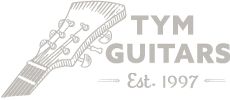1980 Aria Pro II TS-400
Share
Those of you around here know how much I love the Matsumoku factory made guitars, especially the quality from this era. By the late seventies this factory was making some absolutely superb guitars and before closing in 1987 they made some of the greatest guitars on the planet, especially in these later years.
In my younger days I didn't really get into these "timber finish" guitars so much. As a young punk I thought these types of guitars were played by session musos and professional players. Heavily influenced by brands like Alembic who started in the late sixties and made very high end through neck, timber finished guitars from a workshop centered around the Grateful Dead.

By the mid to late seventies these types of guitars were influencing many manufacturers and Japan was there at the forefront of these influences.
Both the Matsumoku and Fujigen factories made high quality guitars and basses heavily influenced by these guitars from the late seventies and well into the eighties. Laminated high quality timber bodies with laminated set or through neck construction was a very expensive and time consuming way of making guitars so these factories offered similar instruments with set and bolt on necks to cover all price points.


The TS series guitars were offered as a bolt on in the Cardinal series (CS), which was essentially the same shape but with cheaper, more slab ash body construction with bolt on maple necks.
However, the TS-400 was introduced in 1979 along with the 500/600/800 (more on them soon) and was a full multi-laminate set neck solid body guitar. Based loosely on an SG shape the TS stood for Tri-Sound and the 400 was the passive electronics version in the line. The 500/600/800 had active electronics and the 6/800 had a full through neck with ebony fretboard.


The body is a beautiful piece of construction using a maple and sycamore laminate with a natural or stained finish. This one is called Japan Brown and shows the grain perfectly.
The set neck is laminated maple and is very comfortable and VERY playable. The fretboard is a beautiful piece of rosewood fitted with a full 24 frets and access all the way to the top. Early versions had this six a side headstock which turned into the more common three a side ARIA/Vantage headstock in 1981. Interestingly the TS "Tri-Sound" was changed to "Thor Sound" around the time of this new headstock with some late six a sides having Thor Sound. There was a very short transition period where the headstocks were three side and looked a little like the later ones but smaller and shorter.


The pickups are all Arias Protomatic humbuckers although different models in the range had slightly different specs like output and coil tapping. These were probably made by Maxon but carry no markings to verify that, which isn't uncommon.
They are strong and high output with heaps of frequency response and sound good in single coil mode as well, which can be hard sometimes. This guitar has a Schaller humbucker fitted to the bridge position which still has the coil tap and phase switch installed.


In '81 when the new headstock came in they introduced the TS-300 model which was the same as these but with a bolt on neck. They still had the multi laminated body giving the impression of a through neck with a bolt on (from the front). This differed from the CS series in body timbers and hardware and electronics. It basically started where the SC series left off although the CS-400 had a set neck and carved top.
These TS (and CS) series only lasted until '83 (except the CS Deluxe) when the whole line was redesigned.

These are exceptional guitars from an exceptional factory and were amazing quality for the price. One of my first guitars was a CS-300 in red stain that I bought because it kinda looked like an SG for about $120 at a second hand shop. It was an amazing guitar for the money.
Matsumoku made some incredible guitars in this 80-87 period for lots of different brands but was mainly used by the Aria brand for domestic and exports. They also made similar guitars for Vantage, Washburn and Westone, and made some great quality Epiphones during this period, among many others.


The Matsumoku factory closed in '87 and Aria kept making guitars in their own factory and soon after moved most manufacturing to Korea. The factory that had been a traditional Japanese cabinet maker, with great woodworking craftsmen, that went on to make (and be party owned by Singer) sewing machine, TV and radio cabinets and had moved into guitar making in the early sixties and went on to become one of the greatest instrument manufacturers ever. When Gibson pulled Epiphone from the factory to save money, and Singer had been in decline for years the factory couldn't afford to buy it outright and folded, leaving behind one of the great guitar makers.

